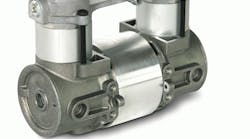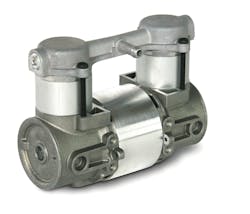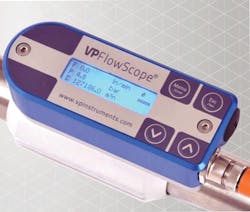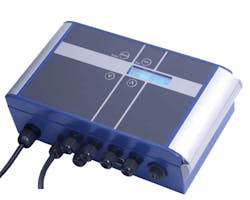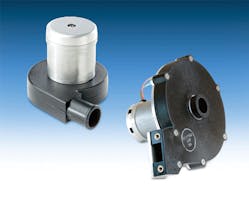Wob-L piston design generates oil-free compressed air.
The 2220 Series compressor from the Thomas Div., a Gardner Denver Co., Sheboygan, Wis., is designed for medical and other applications requiring a compact, lightweight compressor with variable output. The 2220 is a brushless-dc, oilless design that’s small (3.77-in. high × 2.64-in.wide × 4.70-in. long) and weighs only 1.48 lb (0.7 kg).
The compressor has an efficient variable-speed motor that produces flow to 1.1 cfm (32.3 lpm) and pressure to 30 psi (2.1 bar). The 2220 includes permanently lubricated bearings, stainless-steel valves, and wetted parts that are treated for corrosion resistance, all of which contribute to long life. The design takes advantage of Thomas Wob-L piston technology that’s balanced for low-vibration operation, combined with an enclosed crankcase to provide durable yet quiet (45 dBA) performance.
A Wob-L type compressor has a unitary piston rod that “wobbles” inside the cylinder as the crankshaft rotates. Unlike a conventional articulated-piston pump, the Wob-L has no wrist pin connecting the piston rod to the piston. Instead the piston and rod are a single component, usually a casting. The piston rod mounts to an eccentric bearing assembly, which, in turn, connects to the motor shaft and converts rotary motion from the motor into linear motion of the piston within the cylinder.
The piston is sealed to the cylinder by a flanged disk cup that forms both a seal and mechanical guide for the piston. It runs without lubrication against a low-friction, hard-coated cylinder. As the piston is driven up and down, air resistance on the upward stroke expands the disk’s seal on the piston against the cylinder wall to increase its efficiency, while compensating for the wobble action.
A key benefit is oil-free operation, which makes the Wob-L piston design well suited for use in the medical, automotive, and beverage industries. Pressure-versus-flow and vacuum-versus-flow characteristics are generally superior to those of diaphragm pumps. Wob-L-type compressors provide greater flows at any given pressure or vacuum, to ensure more-consistent, longer-life operation in a physically smaller unit. Finally, as a piston pump, an inherent characteristic of the design is that the failure mode is gradual fatigue, rather than a catastrophic failure mode that is characteristic of many other designs.
For more information on the Thomas 2220 Series compressor, visit bit.ly/HqArDD.
Tools for managing compressed air
Compressed air is an expensive energy source. In fact, it is nearly 10 times more expensive than electricity. And studies show that up to 50% of generated compressed air is lost due to leakage, improper use, and lack of maintenance. This is according to experts at Van Putten Instruments B.V., headquartered in Delft, The Netherlands.
Engineers at the company are addressing these problems with a suite of products and software for managing the production and use of compressed air. In many cases, they say, demand for compressed air can be reduced by optimizing a system with proper air management, pressure control, and piping configurations, as well as eliminating leaks. The result can be substantial energy and cost savings.
The company’s product range includes flowmeters and other sensors for measuring compressed-air-system performance, and monitoring systems for total compressed-air management. Some can interface with third-party energy-efficiency software and plant-management packages.
Flowmeters are used to establish baseline airflows and energy use. They allow technicians to perform air audits and system checks and, when permanently installed, continually monitor a system so users can proactively control leaks, scrutinize power consumption and pressure losses, and plan for maintenance to prevent downtime.
The company’s mass flowmeters, based on proprietary, in-house technology, are described as integrated circuits that combine a Wheatstone bridge with a heater. For example, VPFlowScope sensors simultaneously measure mass flow, temperature, and pressure; have a 500,000-point data logger; and include a built-in display with keypad for configuration.
They combine an extremely wide measurement range with flow-direction sensitivity. This lets users measure flow in loop networks and systems with air receivers, which can often be difficult to assess.
The product family consists of wet and dry airflow meters. This lets it monitor wet supply-side pretreated air, as well as clean, dry demand-side air, in piping systems from 0.5 to 20 in. in diameter. Both types use the same display module, so users can measure virtually any compressed-air system with a single instrument.
An in-line version of the VPFlowScope, for 0.5, 1.0, and 2.0‑in.-diameter pipes, also provides real-time flow, pressure, and temperature readings with bidirectional sensitivity. Several versions cover flows from 0.13 to 600 scfm, with a 0.5% accuracy. Pressure range is 0 to 250 psi with ±1.5% accuracy; and temperature rating is 32 to 140°F with ±1° accuracy.
In addition to these products, other flowmeters are available for point-of-use consumption and leak detection; as well as current sensors that measure power input to the compressor’s electric motor. When combined with a flowmeter, current measurements can be used to determine actual compressor efficiency.
To record data and monitor a system, the VPFlowTerminal is a plug-and-play, wall-mount display with built-in power supply and 2 million-point data logger. The unit has five sensor inputs — one input for a mass flowmeter and four generic analog inputs — and it can record up to eight channels. Because it can track main flow and compressor power consumption, it’s suited for monitoring compressor efficiency. It can also be used for air audits because all information is recorded within one data logger.
Another monitoring tool, VPStudio software, lets users configure other VP Instruments products, view real-time measurements, retrieve data, schedule data-log sessions, set logging intervals, and adjust flow-meter parameters. VPStudio communicates with other devices via a PC’s USB port.
To manage a complete network, VPVision software monitors, stores, and analyzes flow and other data and can estimate potential savings. It lets users:
• Get real-time feedback on actual compressed-air consumption.
• Simultaneously monitor multiple compressors.
• Track and manage leakage.
• Allocate compressed-air costs to individual departments or production lines.
• View cost evaluation and savings reports.
• Benchmark different plants around the world on efficiency and costs.
• Generate the necessary documentation for utility incentives.
VPVision can be expanded to receive and consolidate data such as compressor electricity demand and flow-media dew point. It can also be integrated into a plant’s existing SCADA system. VPVision can also be connected to the Internet, allowing remote access by designated staff using devices such as an iPad, smartphone, tablet, or Web browser.
Because no two compressed-air systems are the same, VPVision systems are customized to the user’s requirements. Application engineers at VP Instruments can calculate the required investment and estimate ROI up front, before a potential user makes a purchasing decision. The company’s compressed-air management tools are currently being used in food-processing plants, bakeries, steel mills, and foundries, among others.
For more information on VP Instruments, visit www.vpinstruments.com, call the U. S. Service Center at (740) 862-0084 or e-mail [email protected].
Blower includes full-wave electronic controller
Ametek Precision Motion Control, Kent, Ohio, makes a range of variable-speed brushless blowers, regenerative and transportation blowers, as well as motors, pumps, and fans. Engineers at the company recently upgraded its Microjammer Series of compact, variable-speed brushless blowers to include a state-of-the-art electronic controller. The addition of a full-wave, electronic speed controller reportedly gives users greater functional control while maintaining the unit’s performance characteristics and compact design.
According to company officials, the full-wave commutating electronics package makes the Microjammer blower family more versatile, compared to its previous half-wave version, by providing more protection features and functional options (including a tachometer output), and increasing the opportunity for customization. Previously, all of these benefits were only possible by adding a costly, space-consuming external drive.
Being fully programmable, users no longer need to develop their own “hard” control schemes, but instead can take advantage of an Ametek multiwire input for specific operational functions, including closed-loop speed control, maximum speed set, electric braking, current limit, overtemperature protection, locked rotor, and others.
The upgraded controller also provides a greater range of speed control — virtually 0 to 100% total speed variation is possible. Rather than varying input voltage to produce specific operating characteristics, users can now take full advantage of the on-board signal-level controllability.
Along with these benefits, the upgraded Microjammer blowers offer the potential for greater efficiency, lowering operating costs and making them better suited for applications where energy consumption is a concern. The units now deliver up to 50 in. (water column) of static pressure and generate airflow of 26 cfm.
With low-inertia and high dynamic response, Microjammer blowers are reportedly suited for a variety of high-end blower applications, such as in business machines, computers, medical equipment, and printers. Blower package sizes vary from approximately 3.0 to 5.1 in. in diameter, each providing unique aerodynamic operating characteristics allowing for a custom fit. All units are powered by Ametek’s 1.7-in. brushless 12 or 24-Vdc motor.
For more information on Ametek Precision Motion Control, visit www.ametektip.com.
